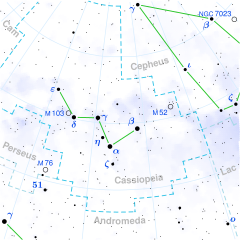
Back Schedar Afrikaans صدر ذات الكرسي Arabic Schedar AST Шэдар Byelorussian Шедар Bulgarian Alpha Cassiopeiae BS Schedar Catalan Schedir Czech Schedir German Schedar Spanish
| Observation data Epoch J2000 Equinox J2000 | |
|---|---|
| Constellation | Cassiopeia |
| Right ascension | 00h 40m 30.4411s[1] |
| Declination | +56° 32′ 14.392″[1] |
| Apparent magnitude (V) | 2.240[2] |
| Characteristics | |
| Spectral type | K0-IIIa[3] |
| U−B color index | 1.14[4] |
| B−V color index | 1.16[4] |
| Variable type | Suspected[5] |
| Astrometry | |
| Radial velocity (Rv) | −4.31 km/s |
| Proper motion (μ) | RA: 50.88[1] mas/yr Dec.: −32.13[1] mas/yr |
| Parallax (π) | 14.29 ± 0.15 mas[1] |
| Distance | 228 ± 2 ly (70.0 ± 0.7 pc) |
| Absolute magnitude (MV) | −2.01[6] |
| Details[7] | |
| Mass | 3.98 M☉ |
| Radius | 45.03+1.57 −1.68[8] R☉ |
| Luminosity | 734±52[8] L☉ |
| Surface gravity (log g) | 1.73 cgs |
| Temperature | 4476±15[8] K |
| Metallicity [Fe/H] | –0.2 dex |
| Rotational velocity (v sin i) | 6.71[9] km/s |
| Age | 220 Myr |
| Other designations | |
| Database references | |
| SIMBAD | data |
Alpha Cassiopeiae or α Cassiopeiae, also named Schedar (/ˈʃɛdɑːr/),[10][11] is a second-magnitude star in the northern constellation of Cassiopeia. Though listed as the "alpha star" by Johann Bayer, α Cas's visual brightness closely matches the 'beta' (β) star in the constellation (Beta Cassiopeiae) and it may appear marginally brighter or dimmer, depending on which passband is used. However, recent calculations from NASA's WISE telescope confirm that α Cas is the brightest in Cassiopeia, with an apparent magnitude of 2.240. Its absolute magnitude is 18 times greater than β Cas, and it is located over four times farther away from the Sun.
- ^ a b c d e van Leeuwen, F (November 2007). "Hipparcos, the New Reduction". Astronomy and Astrophysics. 474 (2): 653–664. arXiv:0708.1752. Bibcode:2007A&A...474..653V. doi:10.1051/0004-6361:20078357. S2CID 18759600.
- ^ Kharchenko, N. V.; Roeser, S. (September 2009). "All-sky Compiled Catalogue of 2.5 million stars". VizieR. Centre de Données astronomiques de Strasbourg. Bibcode:2009yCat.1280....0K. Retrieved 2011-01-06.
- ^ Keenan, Philip C.; McNeil, Raymond C. (1989). "The Perkins catalog of revised MK types for the cooler stars". Astrophysical Journal Supplement Series. 71: 245. Bibcode:1989ApJS...71..245K. doi:10.1086/191373.
- ^ a b Mermilliod, J.-C. (1986). "Compilation of Eggen's UBV data, transformed to UBV (unpublished)". Catalogue of Eggen's UBV Data. Bibcode:1986EgUBV........0M.
- ^ Samus, N. N.; Durlevich, O. V.; et al. (2009). "VizieR Online Data Catalog: General Catalogue of Variable Stars (Samus+ 2007-2013)". VizieR On-line Data Catalog: B/GCVS. Originally Published in: 2009yCat....102025S. 1. Bibcode:2009yCat....102025S.
- ^ Katz, D.; Soubiran, C.; Cayrel, R.; Barbuy, B.; Friel, E.; Bienaymé, O.; Perrin, M. -N. (2011). "Probing the Galactic thick disc vertical properties and interfaces". Astronomy and Astrophysics. 525: A90. Bibcode:2011A&A...525A..90K. doi:10.1051/0004-6361/201014840.
- ^ Reffert, Sabine; Bergmann, Christoph; Quirrenbach, Andreas; Trifonov, Trifon; Künstler, Andreas (2015). "Precise radial velocities of giant stars. VII. Occurrence rate of giant extrasolar planets as a function of mass and metallicity". Astronomy and Astrophysics. 574: A116. arXiv:1412.4634. Bibcode:2015A&A...574A.116R. doi:10.1051/0004-6361/201322360. S2CID 59334290.
- ^ a b c Baines, Ellyn K.; Clark III, James H.; Schmitt, Henrique R.; Stone, Jordan M.; von Braun, Kaspar (2023-12-01). "33 New Stellar Angular Diameters from the NPOI, and Nearly 180 NPOI Diameters as an Ensemble". The Astronomical Journal. 166 (6): 268. Bibcode:2023AJ....166..268B. doi:10.3847/1538-3881/ad08be. ISSN 0004-6256.
- ^ Hekker, S.; Meléndez, J. (2007). "Precise radial velocities of giant stars. III. Spectroscopic stellar parameters". Astronomy and Astrophysics. 475 (3): 1003. arXiv:0709.1145. Bibcode:2007A&A...475.1003H. doi:10.1051/0004-6361:20078233. S2CID 10436552.
- ^ "Schedar". Merriam-Webster.com Dictionary. Merriam-Webster.
- ^ "Naming Stars". IAU.org. Retrieved 18 June 2018.
